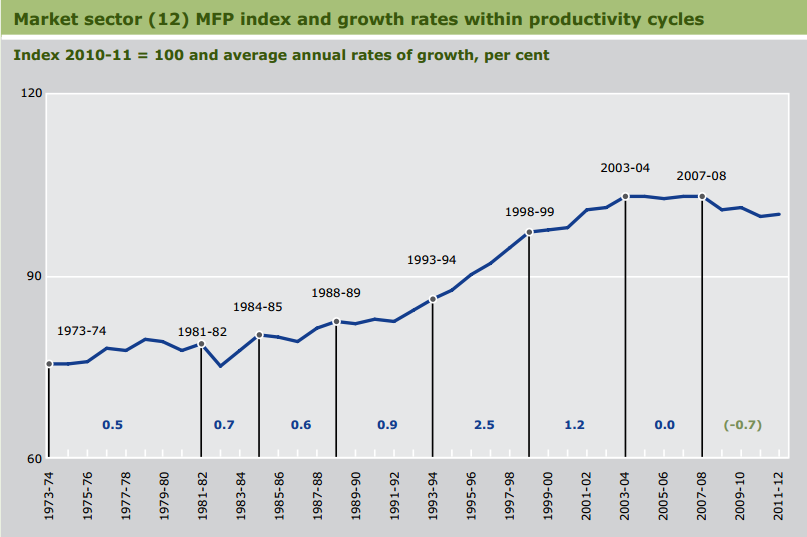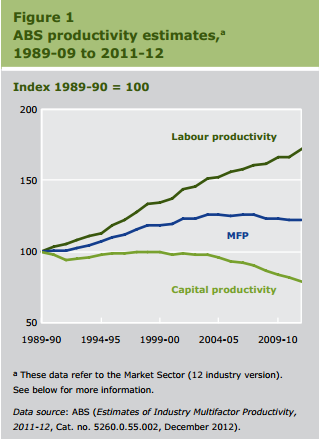Over the at the AFR today, it’s all about manning up for the big productivity push:
Labor’s truce with the business community is under strain with the Business Council of Australia saying it wants decisive policy action on productivity rather than well-meaning joint statements and superficial agreements.
Speaking after a meeting in Melbourne late on Wednesday with the ACTU and Prime Minister Kevin Rudd, BCA president Tony Shepherd also demanded the Prime Minister involve more parties in the productivity debate, saying unions “are not the only stakeholder we should be including”.
“Australia has come a long way from the 1980s and there are many more stakeholders involved in the productivity and competitiveness picture than just unions, who don’t have the influence or the coverage of the workforce that they once had,” he said.
“If the government is serious about tackling our productivity and competitiveness challenges it needs to involve more stakeholders in the discussion going forward and we look forward to that happening.”
After retaking the Labor leadership, Mr Rudd initiated talks with the BCA and ACTU and then flagged a new 1980s Accord-style pact between the two aimed at buttressing the post-mining boom economy by boosting productivity in the non-mining sector .
Mr Rudd set a goal of lifting national productivity growth by 2 percentage points and outlined a “national competitiveness agenda” comprising seven areas on which the BCA and the ACTU agreed focus was needed.
Productivity is not improved by falling wages. Labour productivity is simply a measure of output, usually GDP, divided by labour input, either in per employed person, per working hour, or per capita. Multi-factor productivity is a measure of output divided by the sum of inputs of labour and capital, including land. So a wages accord will not improve productivity. Though it will increase competitiveness.
Let’s examine the magnitude of this challenge for both men. 2% growth in multi-factor productivity would rival the golden period of the nineties:

So, what delivered that? There’s some debate but it’s generally agreed as a combination of two important structural changes. The first was the reforms of the eighties Labor government, cutting tariffs, deregulating labour, privatising government assets, floating the dollar etc.
These reforms can be couched as “opening us up to competition” from within and without.
The second reason is the information technology (IT) revolution. The fundamental rewiring of business and government was an efficiency nirvana. MB is a prime example. Two blokes in a shed can now successfully out-compete literally hundreds in a glassy CBD high rise.
These were both huge structural shifts within the Australian economy and they delivered 2.5% productivity growth in the nineties. Decent periods either side managed an average of 1.1%.
So, in applying this period to our contemporary challenge, and the discussions between Rudd and the BCA, what conclusions can we draw?
The first and most important point to note is that there is no structural reform available of the same magnitude so the task will be harder. Making it more difficult still, in the earlier phases of deregulation there was a great surge in competition, but the latter phases have seen the great consolidation. In almost every industry now we have ruling duopolies and oligopolies that have a minimal spur to compete. Rather, they have become seekers of rent, pouring all of their efforts into preserving fat margins by suppressing competition. This has been made worse still by the bailout culture engendered by the GFC.
In a sense, we’ve come full circle in the reform period, from a stultified economy dominated by sluggish government monopolies, to a stultified economy dominated by sluggish private duopolies. This is one reason why, in my view, capital productivity has stalled and declined (the other reason being the capital intensiveness of the miming boom and land prices):

As you can see in the chart above (from the Productivity Commission), despite the under-performance of capital, there is still a strong correlation between higher labour productivity and higher overall productivity. As we know, labour productivity is almost exclusively lifted via capital aggregation, that is, investing in new machinery, processes or plants that increases worker output per cost of input.
But with business spending most of its time and energy wrestling over rents – with the government, the unions and the people – why would they invest in greater efficiency?
The first challenge for the BCA then is a vigorous campaign for the break-upof the businesses of its members. Laugh out loud!
The first challenge for Rudd is to prevent all further bailouts, massively boost competition based policy and deficit spend on de-bottlenecking infrastructure. Laugh out loud!
There are other reasons for hope. Lot’s of small things might add up to a good boost to productivity. As the mining boom moves to its production phase there’ll be a natural lift in the performance of capital and as prices fall. We will, surely, be forced to invest in infrastructure as slow growth combines with congested cities, rail and ports. The NBN will make a solid contribution. Tradables competition will help. If someone is serious about electricity reform it can contribute. Assuming that the land bubble slow melt goes on, it will help too.
But will it add up to a renewed productivity boom? I have my doubts.

